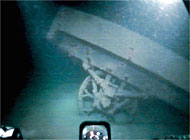Sunken wagons offer insight into early rail transport

A Lausanne diver has located the remains of four railway wagons which sank in Lake Geneva in 1859. The discovery is expected to shed light on how railways were built and operated during the 19th century.
Gilbert Paillex used an underwater robot he developed himself to locate the wagons, some 300 metres under water.
A total of six carriages had been loaded unto a freight ship, which set off from Morges on July 8, 1859. They were meant for use on the railway lines connecting Italy and Switzerland.
A gust of wind, however, intercepted the wagons. The rope which had been used to tie the six carriages together came undone and four of them, each worth around SFr20,000, slipped into the water.
No one was injured in the incident.
Using reports and newspaper articles published at the time, and spurred on by his own curiosity, Paillex set about finding out where the carriages had ended up.
“In the end, I had to make about 20 journeys to find the precise location of the carriages,” says Paillex.
With the aid of a self-designed robot, Paillex dived underwater and took photographs of the carriages, which are still in a relatively good state.
This is not Paillex’s first underwater discovery in Lake Geneva.
“It’s about the 40th time we have made discoveries at the bottom of the lake,” says Paillex. “This one is important because it allows us to find out more about railways and how they were built at that point in history.”
Paillex intends to make further journeys underwater to find out more about the carriages, and to gain more statistics for a model replica being made of them.
In the course of his dives, Paillex has made other notable discoveries. In 1984 he came across a steamer, the “Rhône”, which sank in the lake in 1883, as a result of a collision with another steamer.
swissinfo with agencies

In compliance with the JTI standards
More: SWI swissinfo.ch certified by the Journalism Trust Initiative








You can find an overview of ongoing debates with our journalists here . Please join us!
If you want to start a conversation about a topic raised in this article or want to report factual errors, email us at english@swissinfo.ch.